|
 A
1956 Memorial in the Nation's Capital... AHF's 1956 Memorial
Committee is seeking your help to establish a National Memorial to the
Fallen Heroes of the 1956 Hungarian Revolution in the Nation's Capital! A
1956 Memorial in the Nation's Capital... AHF's 1956 Memorial
Committee is seeking your help to establish a National Memorial to the
Fallen Heroes of the 1956 Hungarian Revolution in the Nation's Capital!
AHF selected the beautiful design "Sprint of 1956," scene here,
by renowned artist Gyuri Hollosy who was also responsible for the Boston
Liberty Square memorial to 1956 and many commissioned works across the
country.
The Man
The Freedom Fighter is depicted as a strong male figure, a powerful fighter
who at present appears worn to shreds and on the verge of collapse due
to his struggles for freedom. In
his continued fight he braces his
right leg in a 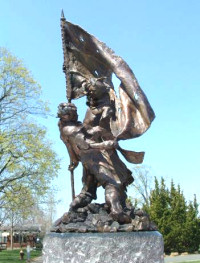 steadfast
position. Disappointed in his efforts he turns his head slightly down
as if he had been betrayed. As he leans backwards with great difficulty,
he holds up the symbol of his cause for freedom and change, the hollow
Hungarian flag of the revolution. The symbolic hole is where the communist
crest existed and has become specifically identified with the 1956 Hungarian
Revolution. The fighter with the other hand clasps the bottom edge of
the flag to express his commitment and allegiance in his belief in God,
to his country and to freedom. steadfast
position. Disappointed in his efforts he turns his head slightly down
as if he had been betrayed. As he leans backwards with great difficulty,
he holds up the symbol of his cause for freedom and change, the hollow
Hungarian flag of the revolution. The symbolic hole is where the communist
crest existed and has become specifically identified with the 1956 Hungarian
Revolution. The fighter with the other hand clasps the bottom edge of
the flag to express his commitment and allegiance in his belief in God,
to his country and to freedom.
The Angel
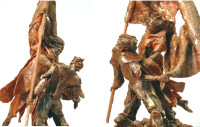 The
angel represents the nation’s belief in God and the hope for the
future. The angel, as an aberration, is visible only through the suggested
cloth movements, and the fighter cannot see but only feel her support.
The face of the angel is a young adolescent student, a Joan D’Arc
type face. The vision swooping down clutches the man’s back and
rescues him from falling while the right hand seizes the sinking flag,
supports it high and straight, and keeping it from touching to the ground.
The angel looks at the man with The
angel represents the nation’s belief in God and the hope for the
future. The angel, as an aberration, is visible only through the suggested
cloth movements, and the fighter cannot see but only feel her support.
The face of the angel is a young adolescent student, a Joan D’Arc
type face. The vision swooping down clutches the man’s back and
rescues him from falling while the right hand seizes the sinking flag,
supports it high and straight, and keeping it from touching to the ground.
The angel looks at the man with 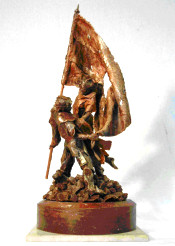 compassion
for his struggles and seeks to install in this patriot revived energy
and encouragement for him to continue his quest. compassion
for his struggles and seeks to install in this patriot revived energy
and encouragement for him to continue his quest.
The
Flag
I
wanted the overall gesture of the flag to feel free and proud, hovering
loosely without restraint in and around the angel’s head and form.
The battered flag with ripped edges and slashes, rendered to reflect cuts
into flesh, depict the tragic and wrenching daily events which afflicted
the Hungarian nation and its people. The flag’s pole, thicker than
normal and coarsely textured, is nailed with 16 nails which symbolically
reminds us of the 16 point manifestos presented by the students during
the October 23rd demonstrations that lead to the uprising.
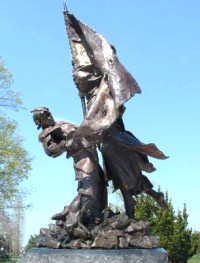 The
Cobble Stones The
Cobble Stones
For the foundation under the figures I used the image of stacked stones
to symbolize the barricades made of cobble stones that were used in the
streets of Budapest to resist the power machines of oppression. These
stones are marked with fossilized etchings of barbed wires to further
emphasize the hardships and imprisonment that the Hungarian people had
to face in their quest for freedom.
Support this important effort!
Contact bryandawson@americanhungarianfederation.org,
join the 1956 Memorial Committee and DONATE NOW!
Contribute or join online!

(You do not need to become a member to donate. The American Hungarian
Federation is a tax-exempt 501c(3) organization and your donations may
be tax-deductible. Please consult a financial advisor.)
The 1956 Hungarian Revolution was the first tear in
the Iron Curtain. Hungarians from all walks of life rose up against insurmountable
odds to fight the brutal Soviet installed Hungarian communist government.
Thousands died fighting, others tortured and executed, while 200,000 were
forced to flee. 2006 marks the 50th Anniversary of the Hungarian Revolution.
AHF's work regarding the tragic events nearly 50
years ago, dates back to the early days of the revolution and
thereafter assisting tens of thousands of refugees. In 1956 the American
Hungarian Federation activated the second Hungarian Relief program for
the refugees of the 1956 Hungarian Revolution, providing $512,560.00.
With the support of the American Hungarian Federation, over 65,000 refugees
arrived in the USA. Get involved and help us continue our tradition of
helping our community!
Join Us!
|
Support this important effort!
Contact Bryan
Dawson and join the 1956 Memorial Committee!
Contribute online!
1) For fastest processing, donate securely online!

2) By mail: Download the AHF
Membership Registration Form and mail it in with your check or money
order payable to "American Hungarian Federation" NOTE: If you
are sending a donation for a specific fund (1956 Fund, for example), please
be sure to include that on the form. (You do not need to become a member
to donate):
American Hungarian Federation
C/O Sandor Murray, Treasurer
2805 56th Place
Woodside NY 11377
 NOTE: You will need the free Adobe Reader to open the document.
Click image to download.
NOTE: You will need the free Adobe Reader to open the document.
Click image to download.
 Sign
up for the AHF mailing list. Sign
up for the AHF mailing list.
Your information is not shared!
Shortcuts to this section:
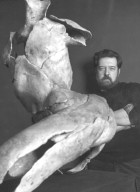 About
Gyuri Hollosy About
Gyuri Hollosy
Gyuri Hollosy’s artistic career, with an emphasis
on sculpture, spans a period of 46 years. Currently, and for the last
30 years, he has been on an endlessly fascinating path of exploration
and development of the human figure. In this time his sculpture has emerged
and evolved into a strongly delicate, unique and personal style. His aim
is to interpret the nuances of the human condition, both emotional and
physical, through his vision and singular style of work.
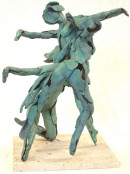 Gyuri’s
Hungarian parents emigrated to Germany in 1945, where he was born in Bad-Aibling
in 1946. In the mid 1950’s his family left Germany to settle in
Cleveland, Ohio. His preteen (10-12) summers were spent at a camp held
at a Hungarian Franciscan monastery outside of Buffalo, New York. These
wonderful men provided a safe haven to the children of Hungarian immigrants
so the parents could have time to focus on establishing themselves in
their new country. During one of these summers he witnessed the building
of a new chapel at the monastery. He had the chance to observe a Franciscan
priest draw images of the saints into large oak pillars with forge-heated
pokers. The smell, the visuals of the hot coals in the hearth and the
marvelous creations they created, ignited in him the spark to be an artist. Gyuri’s
Hungarian parents emigrated to Germany in 1945, where he was born in Bad-Aibling
in 1946. In the mid 1950’s his family left Germany to settle in
Cleveland, Ohio. His preteen (10-12) summers were spent at a camp held
at a Hungarian Franciscan monastery outside of Buffalo, New York. These
wonderful men provided a safe haven to the children of Hungarian immigrants
so the parents could have time to focus on establishing themselves in
their new country. During one of these summers he witnessed the building
of a new chapel at the monastery. He had the chance to observe a Franciscan
priest draw images of the saints into large oak pillars with forge-heated
pokers. The smell, the visuals of the hot coals in the hearth and the
marvelous creations they created, ignited in him the spark to be an artist.
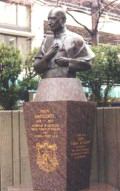 With
his parents, turn-of-the-century Hungarian painters, Simon Hollósy
and Csontváry Tivadar Kosztka, helped him to crystallize his choice
and completely supported his commitment to be an artist. Since that time
he has studied sculpture, ceramics, painting, and drawing, with sculpture
becoming his favorite form of expression. He finds his ideas manifest
themselves most strongly with sculpture where he can work not only with
the three dimensions of a form but also have the tactile pleasure of developing
that form. During the summers of his high school years in the early ‘60s,
he began his education and practice of sculpture by apprenticing to Hungarian
sculptor Frank Varga from Detroit, Michigan. With
his parents, turn-of-the-century Hungarian painters, Simon Hollósy
and Csontváry Tivadar Kosztka, helped him to crystallize his choice
and completely supported his commitment to be an artist. Since that time
he has studied sculpture, ceramics, painting, and drawing, with sculpture
becoming his favorite form of expression. He finds his ideas manifest
themselves most strongly with sculpture where he can work not only with
the three dimensions of a form but also have the tactile pleasure of developing
that form. During the summers of his high school years in the early ‘60s,
he began his education and practice of sculpture by apprenticing to Hungarian
sculptor Frank Varga from Detroit, Michigan.
 After
completing his education and five and half years of military service with
the U.S. Coast Guard he continued his career as a teacher and has taught
at a number of schools, among them Tulane University in New Orleans, Washington
University in St. Louis and Bethany College in Lindsborg, Kansas. In the
late “80s he and his wife moved to New Jersey to work for the Johnson
Atelier Technical Institute of Sculpture as an instructor, an academic
administrator and gallery director. After
completing his education and five and half years of military service with
the U.S. Coast Guard he continued his career as a teacher and has taught
at a number of schools, among them Tulane University in New Orleans, Washington
University in St. Louis and Bethany College in Lindsborg, Kansas. In the
late “80s he and his wife moved to New Jersey to work for the Johnson
Atelier Technical Institute of Sculpture as an instructor, an academic
administrator and gallery director.
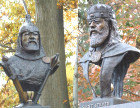 In
the past 20 years he has been awarded three major commissions and six
minor commissions. These works all reflected the specific theme of the
grantor. Some of these pieces invited him to gain further command of highly
technical skills in order to visualize, to express, and to execute his
ideas on a grand scale. With this knowledge he has pursued sculpting on
this large scale with themes of his own creation. He has received several
awards at shows where he has exhibited his personal work. Gyuri has sold
numerous works to collectors and dealers. He has also continued to apply
for grants and to foundations to obtain recognition and receive financial
assistance. In doing so he has gratefully received three grants - the
Helen and George Segal Foundation, the Ludwig Voglestein Foundation and
the Herk van Tongeron Sculpture Fund. In
the past 20 years he has been awarded three major commissions and six
minor commissions. These works all reflected the specific theme of the
grantor. Some of these pieces invited him to gain further command of highly
technical skills in order to visualize, to express, and to execute his
ideas on a grand scale. With this knowledge he has pursued sculpting on
this large scale with themes of his own creation. He has received several
awards at shows where he has exhibited his personal work. Gyuri has sold
numerous works to collectors and dealers. He has also continued to apply
for grants and to foundations to obtain recognition and receive financial
assistance. In doing so he has gratefully received three grants - the
Helen and George Segal Foundation, the Ludwig Voglestein Foundation and
the Herk van Tongeron Sculpture Fund.
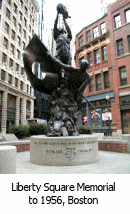 His
sculptural technique has evolved through a number of changes. In his pieces,
his main interest is the development of the human figure, and his desire
is to give the form freedom of gestured expression. His link to the figure
is very classical because of the early influence of the art of Michelangelo
and Rodin. His love for Henry Moore’s work and his understanding
of form inspired Gyuri to take his vision of the human form to a higher
level. Though he never met the man it was through his work and writings
he felt that Moore was his real mentor. His
sculptural technique has evolved through a number of changes. In his pieces,
his main interest is the development of the human figure, and his desire
is to give the form freedom of gestured expression. His link to the figure
is very classical because of the early influence of the art of Michelangelo
and Rodin. His love for Henry Moore’s work and his understanding
of form inspired Gyuri to take his vision of the human form to a higher
level. Though he never met the man it was through his work and writings
he felt that Moore was his real mentor.
“I am intrigued with the interior and exterior space of the human
form. With these sculptural forms, though stationary, I explore the kinetic
rhythm and energy between abstracted figures in space, more specifically,
the delicacy and boldness of motion. Inspired by the Baroque paintings
of Tiepolo, the engaging concepts of Laszlo Maholy-Nagy's visions of motion
and the openness of contemporary dance and its play with gravity, I seek
to unpack the subtle, expressive gesture by showing how two or more figures
symbiotically move - through water, air, across the ground - spiraling
in, cantilevered out, yielding to gravity or emotion. In short, my subject
is the interior landscapes that paired figures create.
I am experimenting with figures not defined by a rigid top and a bottom.
I like to ask these questions; what happens when the piece is tipped on
its side and there is no single right side up? How is the dynamic between
the two bodies changed? How does the re-positioning of the figures re-define
the environment around them – bodies in air, in water, or earthbound?
The challenge is not only to create two engaged bodies, but figures whose
very engagement physical and emotional - changes when the sculpture is
turned from one three-point base to another and another and to achieve
a form that is never at rest. These sculptures can be in from 5 to 9 different
positions, each as powerful as another within its given space. Some of
the changes are great and some are subtle, but all are significant in
the emotional response felt by the viewer.
In 1996 when my father passed away, I found myself wanting to sculpt portraits
of people whose life energy influences my life. Among my completed portraits
are my father, Cardinal Mindszenty, Martin Luther King, the Dali Lama,
Yitzhak Rabin, Raoul Wallenberg and others. A challenge for me was how
to display the head. I decided to depict descriptive elements of the life
and works of the individual in a totem pole that holds the head. This
series is called Kopjafa (Hungarian for totem.) These totems are a very
enriching and satisfying aspect of my artistic life, and I hope to create
many more.”
 New
Videos posted to the 1956 Portal! "News Magazine of the
Screen" presented "Flight from Hungary" in early 1957 featuring
video taken after the brutal Soviet re-occupation.
"This is battered Budapest under the brutal Russian boot, Soviet
tanks roam the streets under the ruins they laid as communist secret police
hunt down heroic Freedom Fighters.
25,000 Hungarians are dead." A fascinating video, it also includes
news about the Suez Crisis an New
Videos posted to the 1956 Portal! "News Magazine of the
Screen" presented "Flight from Hungary" in early 1957 featuring
video taken after the brutal Soviet re-occupation.
"This is battered Budapest under the brutal Russian boot, Soviet
tanks roam the streets under the ruins they laid as communist secret police
hunt down heroic Freedom Fighters.
25,000 Hungarians are dead." A fascinating video, it also includes
news about the Suez Crisis an d
more glimpes into life during this time.
The
American Hungarian Federation is sponsoring the 1956 Portal
to provide a central resource o the 1956 Hungarian Revolution. Go to the
[1956 Portal] d
more glimpes into life during this time.
The
American Hungarian Federation is sponsoring the 1956 Portal
to provide a central resource o the 1956 Hungarian Revolution. Go to the
[1956 Portal]

- Gyuri Hollosy Official
Site
- AHF 1956 Portal - www.hungary1956.com
- The 1956 Institute,
headed by Dr. Janos Reiner, is a great site devoted to exploring the
1956 Hungarian Revolution in English and Hungarian.
- www.celebratingfreedom1956.org
- The Cleveland Hungarian Revolution 50th Anniversary Committee (CHR50)
is organizing a major observance event of this important historical
milestone on October 21st and 22nd, 2006 in Cleveland, Ohio.
- Magyar
Radio Online - includes many audio files and an analysis in Hungarian:
"Ki húzta meg a ravaszt eloször 1956. október
23-án?" "Who was the first to pull the trigger?"
 Time
Magazine gave Hungarian Freedom Fighters the title "Man of
the Year" on July 1, 1957. "The Freedom Fighters filled the
empty bottles with gasoline and corked them with table napkins, making
what they called 'benzine flashes." Time
Magazine gave Hungarian Freedom Fighters the title "Man of
the Year" on July 1, 1957. "The Freedom Fighters filled the
empty bottles with gasoline and corked them with table napkins, making
what they called 'benzine flashes."- The Hungary
Page - offers information on 1956, the 1956 Olympics, the popular
"Nobel Prize Winners and Famous Hungarians," resources on
Trianon, Transylvania, History, Music, and more.
- The
International Committee of the Red Cross (ICRC) is participating
in the international conference entitled "1956 and Hungary: the
Memory of Eyewitnesses - In Search of Freedom and Democracy" that
is currently taking place at the Italian Cultural Centre in Budapest
September 28-29, [read
more]
- Wikipedia
- the free, online encyclopedia that allows readers to manage its content!
- The 1956
Institute in Hungary (1956-os Intézet)
- The 1956
Hungarian Revolution Historical Documentation and Research Foundation
in Hungary - a source for thousands of photographs from the period
- The National
Security Archive at The George Washington University provides a
wealth of information on the 1956 Revolution available for download
in PDF.
- The
1956 Hungarian Revolution - a short chronology of events with pictures
- Pal
Maleter on Wikipedia - the military leader of the Hungarian Revolution
- www.sulinet.hu
has as site that transcribed many of the various speeches given before,
during, and after the revolution - a fascinating chronology from Nagy
to Mindszenty. (Hungarian)
- Az
1956-os Magyar Forradalom igaz története - in Hungarian.
"What the history books left out." Published by the 1956 World
Federation.
- Az
1956-os forradalom története Esztergomban - The Revolution
in Esztergom (in Hungarian)
- Arcok
és sorsok - a great site with photos and biographies of some
1956 Freedom Fighters
- Nagy
Imre október 23-án: Nagy Imre október 23-án
eleinte hallani sem akart arról, hogy a Parlamentbe menjen és
szóljon a tömeghez. Ám mégis megtette. Döbbenetet
érezhetett, amikor lenézett a Parlament ablakából,
s akkor is, amikor kifütyülték az „elvtárs”
megszólítást. Beszéde az alant álló
ismeretlen erovel szembeni aggodalmát és szorongását
mutatja.
Downloads:
- The Hungarian Revolution - Uprising, Budapest 1956:
A synoptic treatise of a major political event of the 20th Century,
a historically tragic period in the life of a nation commemorating the
50th Anniversary of the Revolution and the fallen brave By: Attila J.
Ürményházi (Hobart, Tasmania) and edited by Bryan
Dawson-Szilágyi [download]
|



